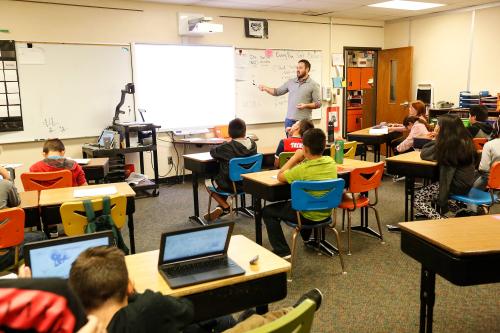The overwhelming majority of public school teachers enter the teaching profession only after completing an apprenticeship as a student teacher. A growing body of research demonstrates how important the student-teaching experience, also known as clinical practice, is for developing teaching capacities and shaping teacher career paths. But recent evidence also points to the broader ramifications of student-teacher placements for teacher hiring and staffing challenges, particularly in rural and disadvantaged schools. In this piece, we summarize the connections between student teaching and the problems that some districts and schools face in staffing teaching positions. We argue that pandemic-induced changes to student teaching can be leveraged to address these long-standing issues in the teacher pipeline.
Why student teaching matters
A number of research studies have connected specific aspects of student-teaching placements to later outcomes of teacher candidates and their students. The collaborative environment of the school in which student teaching occurs has been found to influence value-added measures of future teacher effectiveness and the likelihood of retention in the profession. After being hired into their first job, teachers who had clinical practice classrooms with students who are closely demographically aligned to those in their first teaching assignments tend to be more effective and are also more likely to stay in the profession.
The mentor who supervises student teaching also matters, arguably even more than the environment of the school hosting student teaching. Being assigned to a higher-quality mentor contributes to the development of teaching capacities during clinical practice, and having a mentor with higher performance ratings is associated with better performance ratings among teacher candidates that go on to become teachers. Similarly, when mentors have higher value-added effectiveness, their mentees tend to become more effective teachers.
The geography of student teaching and teacher staffing challenges
While the above findings highlight the importance of mentors and schools in a student teacher’s career, emerging evidence suggests that the geography of student teaching is important as well. Like hiring in the teacher labor market, the placement of student teachers is quite localized. Placements tend to occur close to teacher education programs and candidates’ hometowns. This makes sense given that field instructors from universities oversee student teaching and geographic proximity makes it easier to observe and guide student teachers. But establishing relationships primarily with schools nearby teacher education programs is also limiting. For example, while there are often many schools and teachers within a geographic proximity of teacher education programs, better fits may exist further away from a candidate’s university.
The geography of student-teacher placements also has implications for the supply of new teachers into schools because of the high likelihood a student teacher is hired into a job in their student-teaching school or district. For instance, about 15% of student teachers end up employed in the very same school in which student teaching occurs, and about 40% end up teaching in the same district. Given that teacher education programs themselves tend to be in urban and more advantaged geographic areas, placing student teachers nearby has strong equity and distributional implications. It is no surprise, for example, that rural and high-poverty schools—which tend to face greater challenges in staffing classrooms—are precisely the kinds of schools that are less likely to host student teachers.
This relationship is illustrated in recent work we completed in Washington state showing the connection between student teaching and staffing challenges. The figure below shows all school districts in Washington with each district represented by a single bubble that varies in size and color. The size of each bubble represents the proportion of the district’s new hires who are hired on an emergency credential, where larger sizes represent greater difficulty filling teacher vacancies. The color of each bubble indicates the proportion of teachers in the district that hosted a student teacher from one of the programs participating in the study, where deeper reds show less frequent hosting.
A close look at the figure shows that there are many small blue bubbles and many large red bubbles. The small blue bubbles indicate a greater frequency of student-teacher hosting that coincides with fewer staffing challenges for the district. Unsurprisingly, these districts tend to be more geographically proximate to teacher programs. The large red bubbles tend to be further removed from teacher programs, simultaneously limiting opportunities for hosting student teachers and increasing staffing challenges. This relationship is also borne out by more sophisticated statistical modeling in the academic paper
Figure 1: Proportion of Emergency Substitute Teachers and Proportion of Teachers Hosting Student Teachers

Leveraging pandemic responses to address issues in the teacher pipeline
Could a change in how teacher training programs place their student teachers reduce the hiring challenges experienced by far-flung districts?
The relationship between student-teaching placements and staffing suggests that we need to take a second look at the propensity to place student teachers in districts that are close to teacher education programs. This would include, for instance, forming new relationships with more remote districts that have not previously hosted student teachers, the very districts that tend to struggle most with teacher recruitment. This is an opportune time to consider these changes, given that traditional student teaching has been upended because of the COVID-19 pandemic.
Many apprenticeships are now happening virtually, and while we all hope that in-person schooling becomes more normal as vaccination rates rise, there may be valuable lessons learned from the pandemic experience. In particular, education programs forced to learn how to supervise and communicate with teacher candidates virtually might take advantage of this learning going forward. Thus, while there are clear logistical reasons to keep student teaching geographically close to teacher education programs, we argue it is time to leverage what has been learned from remote supervision of student teaching and rethink pre-pandemic patterns.
More generally, it is important to recognize that there is tremendous scope for change in existing student-teaching assignments. As our work has shown, only about 3% of teachers serve as mentors in any year. There are some good examples of how education programs and states are thinking strategically about how placements can be used to help develop the teachers of tomorrow and get them into high-needs schools.
Louisiana’s Believe and Prepare initiative, for instance, is focused on making sure that teacher candidates have high-quality student-teaching placements and provide incentives to encourage connections between teacher education programs and rural school districts. The Washington state Legislature also recently passed a bill explicitly incentivizing student-teacher placements in rural districts. And, a recent experiment in Tennessee involving a partnership between the state and a large teacher education program shows that providing suggestions of high-quality mentors to partnering districts led to the recruitment of more effective and experienced mentor teachers, and that the teacher candidates who worked in those districts reported feeling better prepared to teach.
If we are interested in the developmental aspects of clinical practice, we should de-emphasize the existing consideration of geography in student-teacher placements. Instead, we should prioritize aspects that have been found to make a difference for teachers and schools including the learning environment of student-teaching placements and the needs of individual candidates and districts.






Commentary
Rethinking the geography of student-teaching placements in a post-COVID-19 world
February 8, 2021